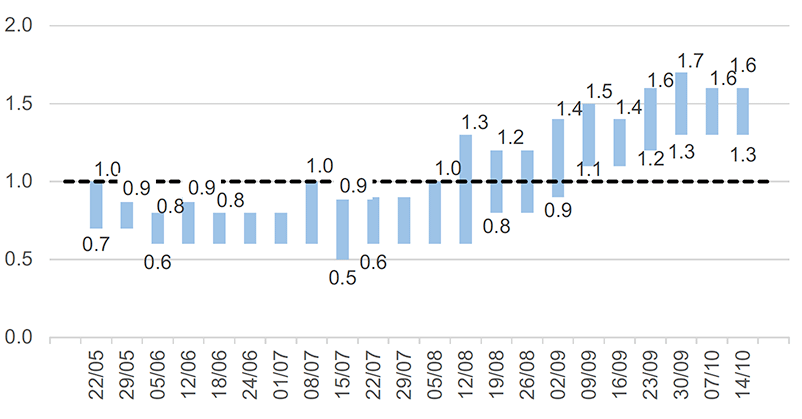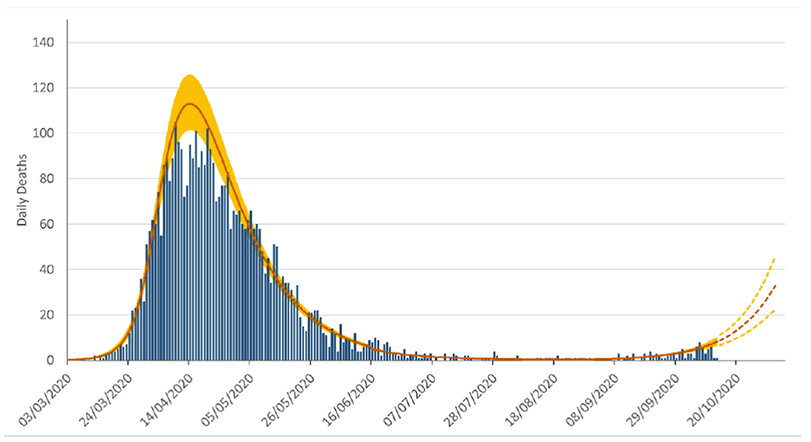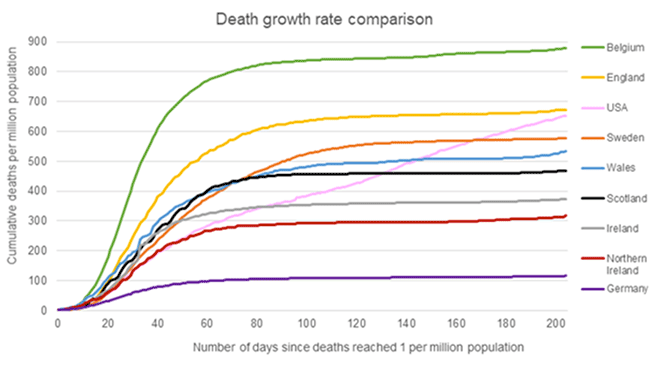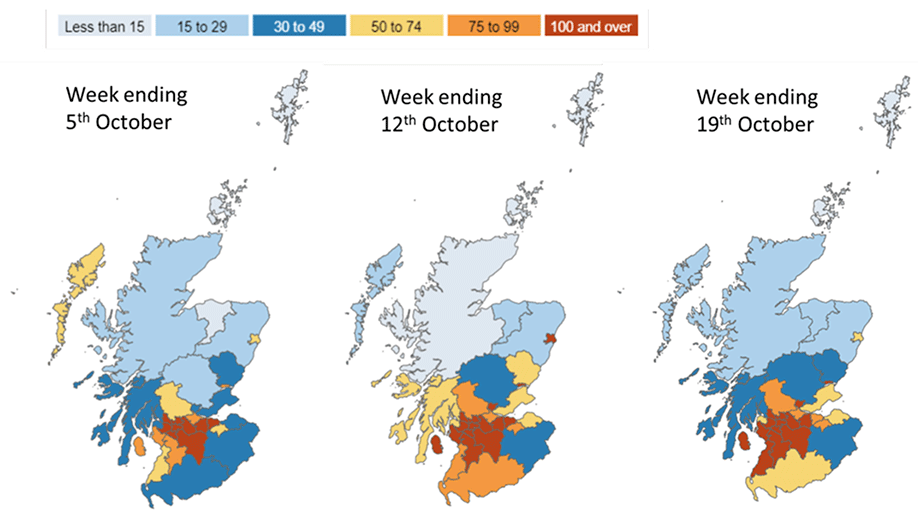Coronavirus (COVID-19): Scotland's Strategic Framework
This document sets out our strategic approach to suppress the virus to the lowest possible level and keep it there, while we strive to return to a more normal life for as many people as possible.
3. Introduction
Setting the context
Since the first COVID-19 cases were notified in Scotland, and the World Health Organisation declared a global pandemic 7 months ago, we have achieved a significant amount – suppressing the virus to a low enough level to enable us to begin lifting restrictions on our daily lives, and creating a strong base for economic and social recovery.
We have been guided by the evidence, lifting protective measures in a phased and gradual way which safeguards public health, underpinned by Scotland's route map through and out of the crisis. While this enabled us to follow a structured yet flexible path in suppressing the virus and reopening our society, it also created increased opportunities for transmission, as set out in recent clinical evidence from the Chief Medical Officer, Chief Nursing Officer, and National Clinical Director.
Most pressingly, while our collective efforts meant we witnessed a significant decline in the rate of growth of the virus, as we reopened our economy and society, the reproduction rate, or 'R' number, has risen significantly above one, leading to rising numbers of cases and test positivity rate in most areas of Scotland. Hospital and intensive care unit (ICU) admissions – while low, relative to start of the pandemic – have also started to increase, following a sustained decline since April.

Source: Scottish Government Modelling[1]
For too many people, the virus has taken a grave toll, and we have lost too many people to it – each and every one a personal tragedy. While our efforts to suppress the virus during the summer meant we were thankfully able to see the number of deaths decline significantly, and at points to zero, they have now started to increase again.

Source: Scottish Government estimates modelled using Imperial College model code
Scotland is not unique in, or immune from, dealing with the tragic effects of the virus, as shown in the figure below. It has taken a grave personal toll already, while infection and prevalence rates increase across the world.

Source: ECDC[2] UK nation data provided by UK Government and ONS. Please note there are variations in how countries record deaths associated with COVID-19.
All countries are focussed on securing their own individual recovery, but suppressing the virus globally helps all of us, by reducing the risks of cross-border importation. While our efforts through lockdown suppressed the virus in the summer, recent spikes have resulted, in part, from domestic and international travel. We will take an evidence-based approach to the difficult but necessary issues of quarantine and travel restrictions.
As we have progressed through the crisis, we have also needed to be much more aware of, and respond to, local variations. A small number of local authorities now make up the vast majority of new positive cases, and evidence suggests there may be a 'ripple' effect spreading from existing areas of high case numbers and growth into neighbouring areas.

Source: Public Health Scotland Dashboard[3]
As we moved into the autumn, not only did we reach the limit of what we could safely open up, we required additional measures to slow the spread of the virus and safeguard public health. Getting to the final phase of the Route Map, where the virus no longer poses a significant risk to public health in Scotland will be dependent upon scientific developments, including the roll-out of an effective vaccine and/or the development of a highly effective treatment. Despite learning huge amounts about the virus, such breakthroughs may yet be some time away. We now need to take a new approach which enables proportionate but rapid action.
Strategic Intent
Recognising this context, our strategic intent, shared across the four nations of the United Kingdom, is to suppress the virus to the lowest possible level and to keep it there, while we strive to return to a more normal life for as many people as possible – what we have referred to as an elimination strategy. Building on our initial focus to protect individuals from, and safeguard the capacity of our NHS to deal with, the impacts of the virus, we will work determinedly, energetically and cooperatively to:
- Make sure people can work and socialise safely, communicating clearly and effectively the steps we all need to take
- Provide tests to those with symptoms and trace their contacts; and seek to prevent new index cases through surveillance and our approach to travel arrangements
- Respond quickly to contain any localised outbreaks, wherever they occur
- Prepare for the pressures we know the winter will bring
- Protect the most vulnerable to harm in society from the effects of the virus
- Help the economy and society recover and renew
- Reach a long-term solution in the form of a treatment or vaccine as soon as possible.
Four harms approach
We must also recognise that, while the pandemic remains a global health crisis, its impacts are far reaching. This framework sets out how we intend to respond to the crisis over the coming period across the four key harms of the virus.
1. The virus causes direct and tragic harm to people's health. We must suppress the virus. To do that we will:
- Introduce a new levels-based approach of protective measures, with graduated packages of measures at each level to reduce transmission of the virus which can be applied locally or nationally, according to the evolving patterns of infection and transmission
- Expand testing capacity through NHS regional hubs and increased lab capacity which we will deploy based on clinical advice and public need
- Retain a primary focus on testing those with symptoms/who need clinical care, with additional capacity targeted towards asymptomatic testing to protect those most vulnerable to harm
- Work with partners including Public Health Scotland and the Care Inspectorate to ensure care homes and services delivering care at home have the necessary guidance and support in infection prevention control, and to monitor trends, identify risks and take early action
- Work with the travel industry to refine the process of quarantine, and examine the feasibility of using testing to reduce the burden of quarantine
- Place a stronger focus on compliance with guidance and rules, through new marketing campaigns, and enhanced support to help people and businesses to comply
2. The virus has a wider impact on our health and social care services, and our wider health and wellbeing. We must support broader health. To do that we will:
- Introduce new advice and guidance on shielding, linked to the protection levels, and place a focus on ensuring all our interventions respond to the needs of clinically at-risk groups
- Ensure the necessary mental health support services are in place to protect people's wellbeing, including expanding access to digital and online help
- Deliver our largest ever flu immunisation programme, and build on existing infrastructure to plan for the delivery of a mass population vaccination programme for COVID-19 as soon as a safe and effective vaccination is developed
- Work to safely resume health services impacted by COVID-19 as far as we can, while simultaneously delivering additional surge capacity of over 4,000 acute beds, utilising the Louisa Jordan as necessary. We have also convened a Winter Planning and Response Group, and allocated £1.1 billion for additional COVID-19 related costs
3. The measures necessary to protect us from the virus can in turn cause harm to our broader way of living and society. We must mitigate social harms. To do that we will:
- Alongside our local authority partners, continue to provide support to individuals and families, including: extending support to help people access essentials such as food and fuel, continuing free school meal provision over the Christmas, February and Easter holidays, and helping people experiencing the most acute forms of homelessness
- Work with local authorities and agencies, prioritise keeping schools, early learning and childcare open, strengthening protection measures where necessary whilst ensuring effective plans are in place should remote learning be required, and to maintain access to childcare and family support for the most vulnerable to harm
4. Protective measures have a damaging effect on our prosperity. We must support the economy. To do that we will:
- Introduce a new package of financial support for businesses who are required to close through the new protective levels, or are otherwise affected. This will include grants across the period businesses are required to close, as well as hardship and discretionary funds
- Work with business to help them minimise the risk of Covid within their activities through guidance, support and enforcement
- Take forward our national mission to help create new jobs, good jobs and green jobs, through our Youth Guarantee, National Training Transition Fund, and investment in skills training and digital
All these harms are related and will require tough choices in determining priorities, some of which cannot always follow a simple comparison of risks. However, in making decisions about the future measures, we have weighed up not just the transmission risk inherent in different settings and activities, but also the impacts on broader health and well-being, society and the economy. To bring transparency to our decisions, and to support people to understand the very difficult issues that we face, we publish data on these harms online.
This framework sets out how we will take a "whole system approach" to supressing the virus, while all the time seeking to minimise broader harms. We will renew our approach to outbreak management, backed by increased testing capacity and contact tracing. We will also provide support to individuals, particularly those most at risk through health or social inequalities, and ensure businesses have the support they need to get through the crisis, within the resources available to us. We will ensure our health and care services are placed on the strongest possible footing, ahead of the additional challenges of the winter period and any renewed spike in the virus. And we will continue to be guided by the principles and approach set out in our Framework for Decision Making.
People and business across Scotland have made significant sacrifices during the pandemic. We should not expect a return to complete normality in the short term. While we understand frustrations with restrictions on peoples' lives, following a cautious approach will lay the foundations for recovery and reduce the risk of a nationwide resurgence of the virus. It will enable as much of our society to function as is safe, and ensure we are in the best position ahead of winter.
Principles and Approach
Our approach will continue to be to:
- Suppress the virus through compliance, with physical distancing and hygiene measures, ensuring the reproduction number remains below 1 and our NHS remains within capacity
- Care for those who need it, whether infected by the virus or not
- Do everything we can to support people, business and organisations
- Recover as a society and an economy, carefully easing restrictions when safe to do so while maintaining necessary measures and ensuring that transmission remains controlled, supported by developments in medicine and technology
- Protect against this and future pandemics, including through effective testing, contact tracing and isolation
- Renew our country, building a fairer and more sustainable economy and society
Our decision making will always be guided by clear principles:
- Safe: We will ensure that transmission of the virus remains suppressed and that our NHS and care services are not overwhelmed
- Lawful: We will respect the rule of law which will include ensuring that any restrictions are justified, necessary and proportionate
- Evidence-based: We will use the best available evidence and analysis
- Fair & Ethical: We will uphold the principles of human dignity, autonomy, respect and equality
- Clear: We will provide clarity to the public to enable compliance, engagement and accountability
- Realistic: We will consider the viability and effectiveness of options
- Collective: We will work with partners and stakeholders, including local authorities, the UK Government and other Devolved Nations, ensuring we meet the needs of Scotland
Contact
Email: covidexitstrategy@gov.scot
There is a problem
Thanks for your feedback